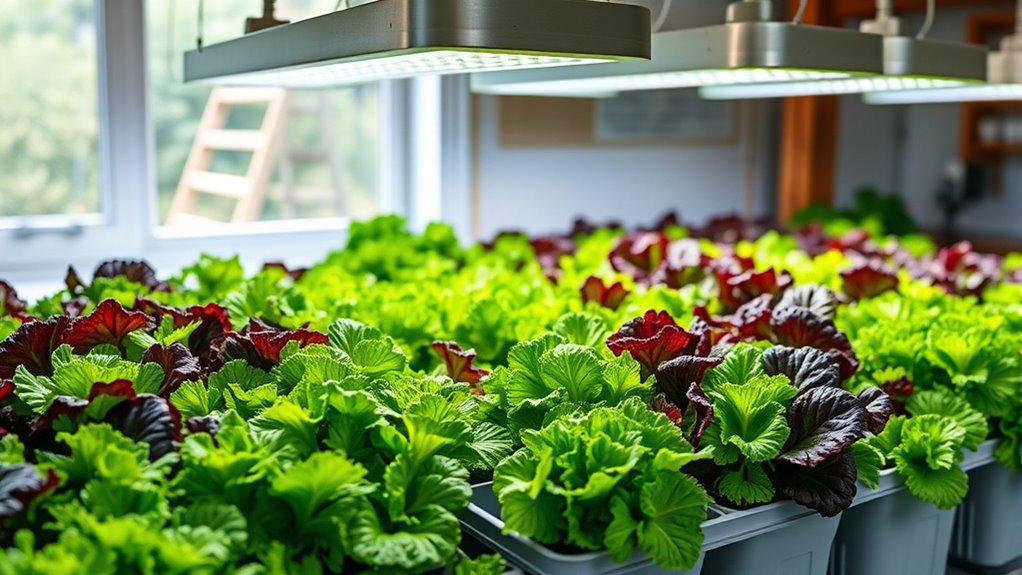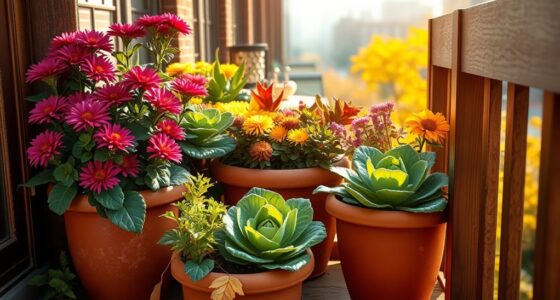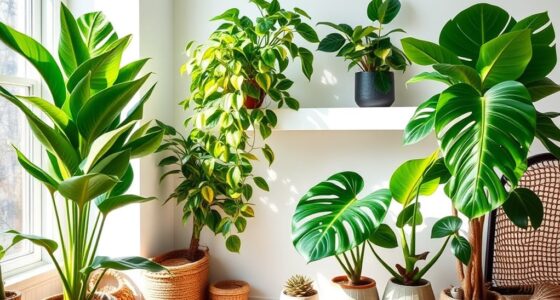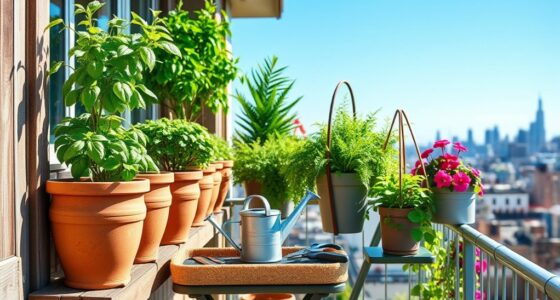To grow salad greens indoors all winter, select shallow containers with good drainage and high-quality soil or seed-starting mix. Use full-spectrum LED or fluorescent grow lights placed about 2-4 inches above your greens, providing 12-16 hours of light daily. Choose cold-hardy and fast-growing varieties like arugula, radishes, and lettuce. Maintain proper watering and humidity levels, and replant or harvest regularly for a continuous supply. Keep exploring for more tips to guarantee year-round success.
Key Takeaways
- Use shallow containers with good drainage and high-quality, well-draining soil for healthy root growth indoors.
- Provide 12-16 hours of full-spectrum LED or fluorescent lighting positioned 2-4 inches above plants.
- Select cold-hardy, fast-growing green varieties like arugula, radishes, and spinach for winter cultivation.
- Water when the soil top inch feels dry, maintaining 40-60% humidity with proper airflow and moisture control.
- Harvest outer leaves regularly and replant cuttings or seedlings every 2-3 weeks for continuous greens.
Selecting the Right Containers and Soil for Indoor Greens
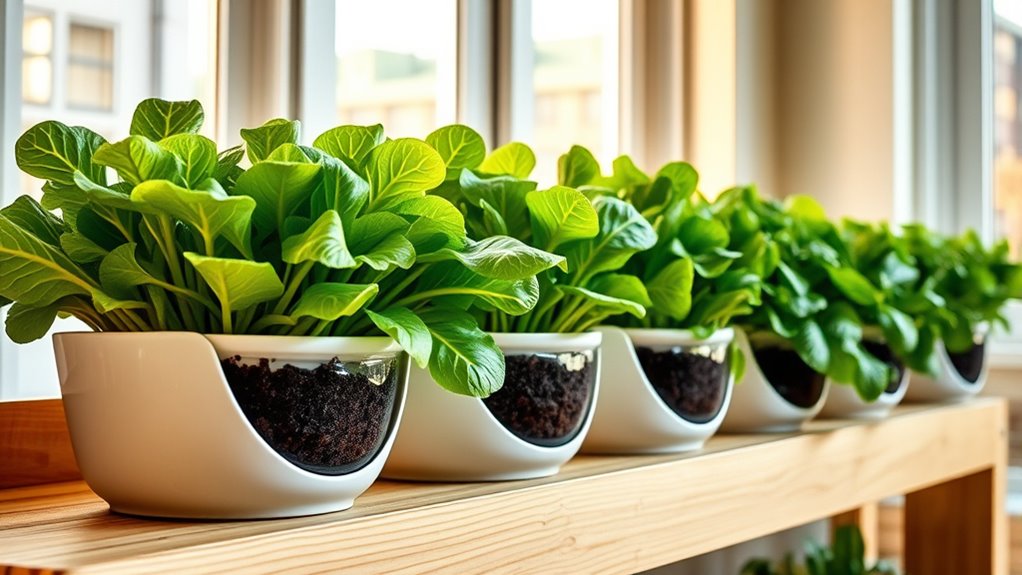
To grow healthy salad greens indoors all winter, choosing the right containers and soil is crucial. Opt for shallow containers with drainage holes, like plastic pots, seed trays, or recycled produce containers, to prevent waterlogging.
Line them with newspaper or weed fabric to improve drainage and retain soil while suppressing weeds. Use a high-quality seed-starting mix or a blend of sterile soil with compost to supply essential nutrients and promote strong root growth.
Make sure the soil is loose, well-draining, and moist but not waterlogged—this balance encourages vigorous greens development indoors. Proper containers and soil setup ensure your greens stay healthy, grow quickly, and resist issues caused by excess moisture. Incorporating soil drainage techniques can further enhance root health and prevent root rot, setting a strong foundation for successful winter gardening.
Essential Lighting Options for Growing Salad Greens Indoors
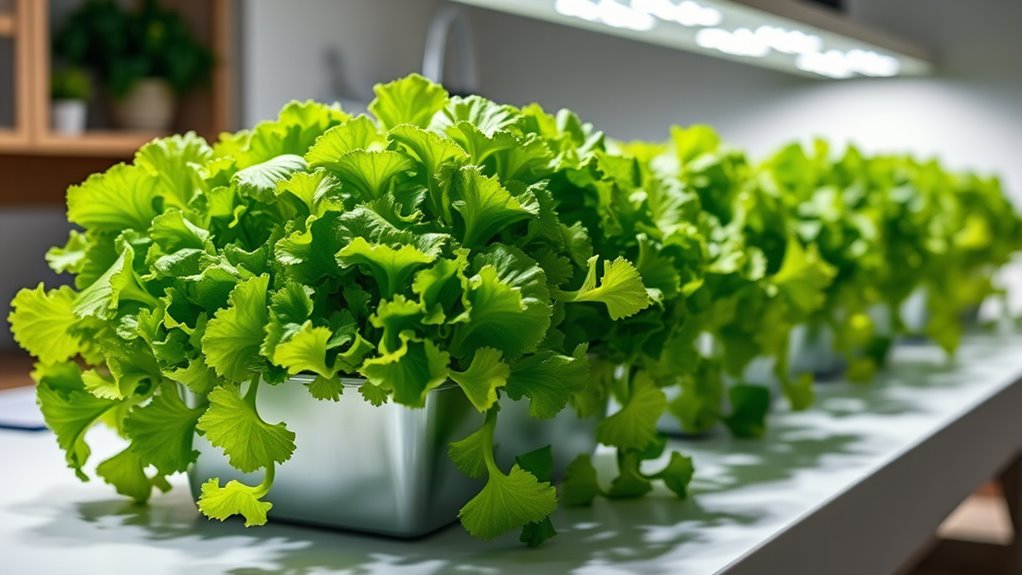
Proper lighting is essential for thriving indoor salad greens, as it provides the energy plants need for healthy growth and photosynthesis. To guarantee your indoor garden flourishes, consider these options:
Excellent lighting is key to healthy, lush indoor salad greens through proper energy and photosynthesis.
- Use full spectrum fluorescent lights like T5 or T8 bulbs, which offer the ideal light spectrum for photosynthesis. These lights are widely available and effective for small-scale indoor gardening.
- Opt for LED grow lights designed for indoor gardening, providing energy-efficient, adjustable lighting that promotes compact, vigorous greens. Many modern LED options include dimmable features to customize light intensity based on plant needs.
- Position your lights within 2 inches of the plant tops initially, raising them gradually to 4 inches as your greens grow, preventing scorching and encouraging uniform development. Additionally, choosing the right lighting equipment can significantly impact your plant health and yield. Proper placement and appropriate light duration are equally important to optimize growth conditions.
Best Seeds and Varieties for a Winter Salad Garden
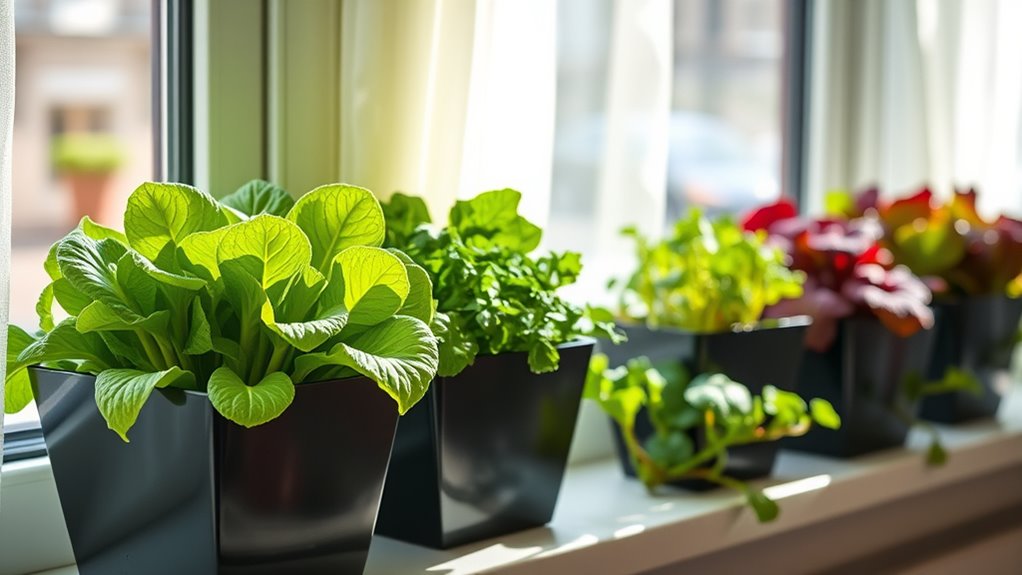
Choosing the right seeds and varieties is essential for a successful winter salad garden indoors. For winter salad greens, opt for seed varieties like Black-Seeded Simpson, Winter Density, and Arctic King, which tolerate low temperatures and indoor conditions. These cold-hardy greens thrive with proper indoor gardening setups, especially when supplemented with grow lights that mimic winter daylight. Implementing automation in business can help streamline watering and lighting schedules, ensuring optimal growth conditions. Additionally, selecting unique and wicked planters can enhance the aesthetic appeal of your indoor garden while providing functional benefits. Fast-growing options such as radishes, arugula, and pea shoots allow you to harvest in just 3-4 weeks, providing continuous fresh greens throughout winter. Organic seed suppliers like High Mowing and Johnny’s offer winter-friendly, non-GMO varieties perfect for indoor germination. Mixing different seed varieties ensures a diverse, flavorful winter salad harvest, making your indoor garden both productive and exciting. Incorporating indoor gardening techniques can maximize space and yield, and understanding local climate conditions can help you choose the most suitable varieties for your environment, especially since some indoor environments may require additional humidity or temperature control to optimize growth.
Setting Up Your Indoor Growing Space for Success
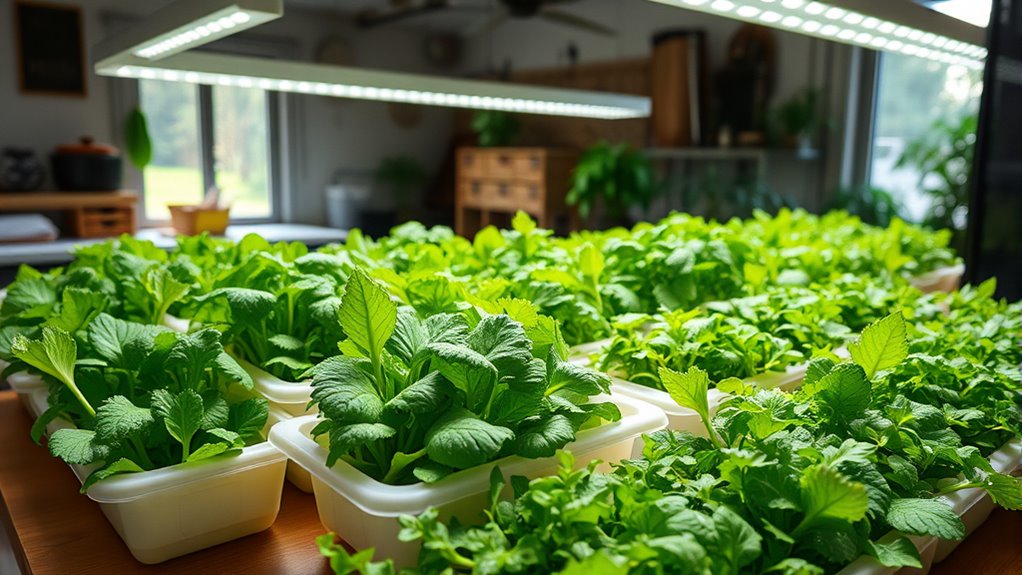
Setting up your indoor growing space for success begins with selecting a spot that provides ample light and stable temperatures. Make certain you have either a south-facing window or set up grow lights that give 12-16 hours of light daily to promote healthy greens. Proper planning ahead can help prevent unexpected costs and ensure your greens receive the appropriate care. Use shallow containers with drainage holes, filled with a sterile seed-starting mix or a soil and compost blend, to support strong root growth. Place your containers in a warm, draft-free area where the temperature stays above 50°F, encouraging germination and steady growth. Additionally, understanding asset division laws can help you make informed decisions about your property if you ever need to divide assets during a divorce. It’s also beneficial to research indoor garden setup techniques to optimize your growing environment. Incorporating energy-efficient lighting options, such as LED grow lights, can further reduce your utility costs and promote sustainable gardening practices. Ensuring proper plant nutrition through appropriate fertilization can also support vigorous growth and healthy greens. To keep your greens thriving, focus on:
- Proper watering—moist but not waterlogged soil
- Adequate lighting—using grow lights or sunlight
- Maintaining consistent temperature for ideal growth
Step-by-Step Guide to Planting and Germinating Seeds
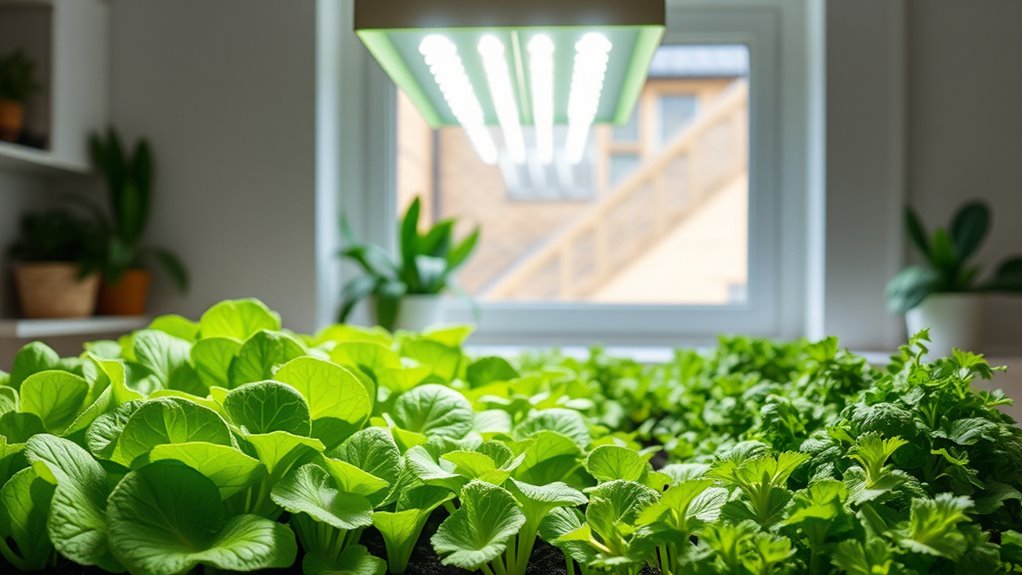
To start planting your salad greens, soak 1 tablespoon of seeds like sunflower, pea, radish, or buckwheat in water for 6 to 24 hours.
After soaking, prepare your soil by mixing 1 quart of water with 1 gallon of sterile seed-starting soil or germination mix.
Mix 1 quart of water with 1 gallon of sterile seed-starting soil to prepare your planting mix.
Fill small containers or trays with this moist soil.
Scatter the soaked seeds evenly on the surface, pressing them gently into the soil without overcrowding.
Cover the seeds with damp newspaper or plastic to keep humidity high.
Place the containers in a dark, warm spot for 4-6 days until germination occurs.
Once seedlings appear, transfer the trays into a well-lit area or under grow lights.
Water daily to keep the soil moist but not soggy.
Maintaining Optimal Watering and Humidity Levels
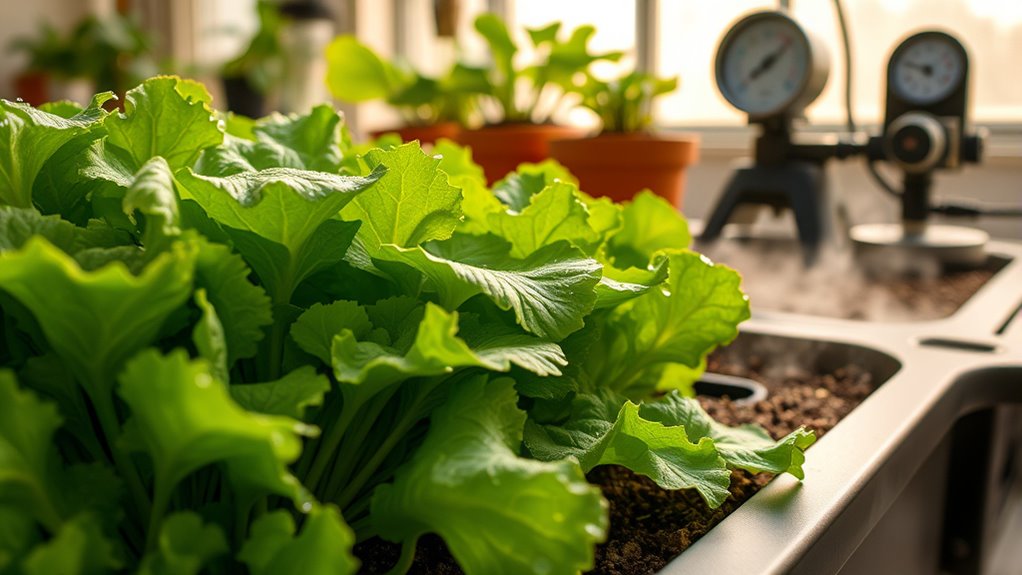
To keep your greens healthy, you need to water them properly—water when the top inch feels dry and use gentle methods to avoid oversaturating the soil. Recognizing patterns in angel numbers can enhance your awareness of love opportunities and spiritual connections. Maintaining the right humidity level, around 40-60%, is essential for lush growth and preventing disease; use a hygrometer to monitor and adjust as needed. Regularly check moisture levels to ensure your plants stay happy and avoid fluctuations caused by drafts or heat sources. Being aware of environmental conditions like humidity and temperature helps create an optimal growing environment for your indoor greens. Incorporating data-driven strategies can help you fine-tune watering and humidity to maximize plant health. Additionally, monitoring vacuum cleaner performance metrics such as humidity control features in certain models can assist in maintaining a stable environment for your plants.
Proper Watering Techniques
Maintaining proper watering and humidity levels is essential for healthy indoor salad greens. To do this effectively, follow these steps:
- Check the soil’s moisture by feeling the top inch; water when it feels dry, usually every 1-2 days, to keep the soil consistently moist without overwatering.
- Use a watering can with a fine rose or spray nozzle to evenly soak the soil, ensuring water reaches the root zone while preventing runoff and waterlogging.
- Maintain humidity by misting leaves regularly or placing trays of water nearby, which helps prevent dehydration and supports vigorous growth.
Ensure your containers have proper drainage to avoid standing water, and adjust watering based on indoor temperature and humidity for ideal results.
Humidity Balance Tips
Balancing humidity levels is key to healthy indoor salad greens, as both too little and too much moisture can cause problems. Too much humidity fosters mold growth and root rot, while too little can dry out your plants. To maintain ideal moisture, keep humidity between 40-60%. Use a humidifier or pebble tray with water beneath your containers to boost ambient moisture. Ensure good air circulation with fans or open vents to prevent stagnant, overly humid conditions that encourage mold. Regularly check your hygrometer to monitor humidity levels and make adjustments as needed. Proper humidity management is also essential for preventing plant stress and promoting healthy growth. Consistently maintaining stable humidity levels can help prevent abrupt environmental fluctuations that stress plants. Additionally, incorporating humidity control devices can further optimize your indoor gardening environment. Here’s a quick guide:
| Humidity Level | Action |
|---|---|
| Below 40% | Increase moisture with humidifier or water tray |
| 40-60% | Perfect—maintain with monitoring |
| Above 60% | Improve air circulation, reduce humidity sources |
Monitoring Moisture Levels
Regularly monitoring soil moisture guarantees your salad greens stay healthy and avoid overwatering. Check the top inch of soil by feeling it; water only when it feels dry to maintain proper moisture levels. Use a watering can with a rose attachment to ensure even watering without disturbing seedlings or causing runoff. Keep these tips in mind: 1. Test soil moisture frequently to prevent overwatering or underwatering. 2. Use a watering can with a rose to water gently and evenly. 3. Misting lightly or using a humidity tray helps maintain humidity, especially in dry winter air. Additionally, maintaining proper humidity levels can also be supported by indoor air quality improvements, which help create a more stable environment for your greens. Ensuring good ventilation can further help regulate humidity and prevent mold growth. Incorporating an air purifier with humidistat control can also assist in maintaining consistent humidity levels while improving overall air quality.
Managing Light Cycles and Adjusting as Plants Grow
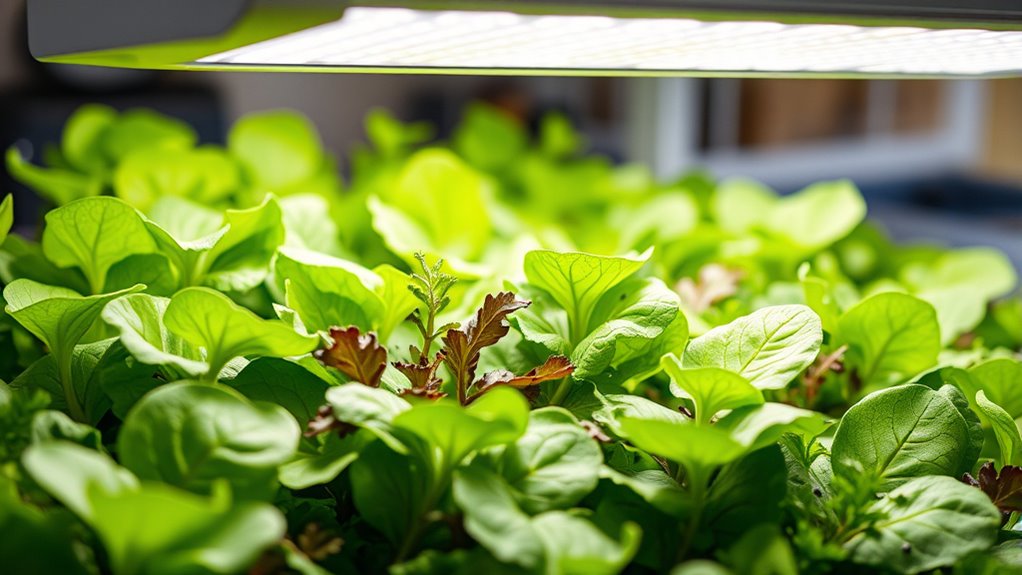
As your salad greens grow taller indoors, it’s essential to adjust their light cycle and positioning to keep them healthy and prevent stretch. Use grow lights to provide a consistent 12-16 hour light cycle daily, which promotes ideal plant growth.
As the plants increase in height, gradually raise the light source to stay within 2-4 inches of the plant tops—this prevents leggy, weak stems. You can adjust the height easily with adjustable fixtures or support structures like books or boxes.
Keep an eye on your plants for signs of stress or etiolation, and reduce the light duration if needed. Regularly monitoring their response allows you to fine-tune the light cycle and distance, ensuring your indoor gardening efforts result in lush, healthy greens all winter long.
Harvesting and Replanting for Continuous Greens
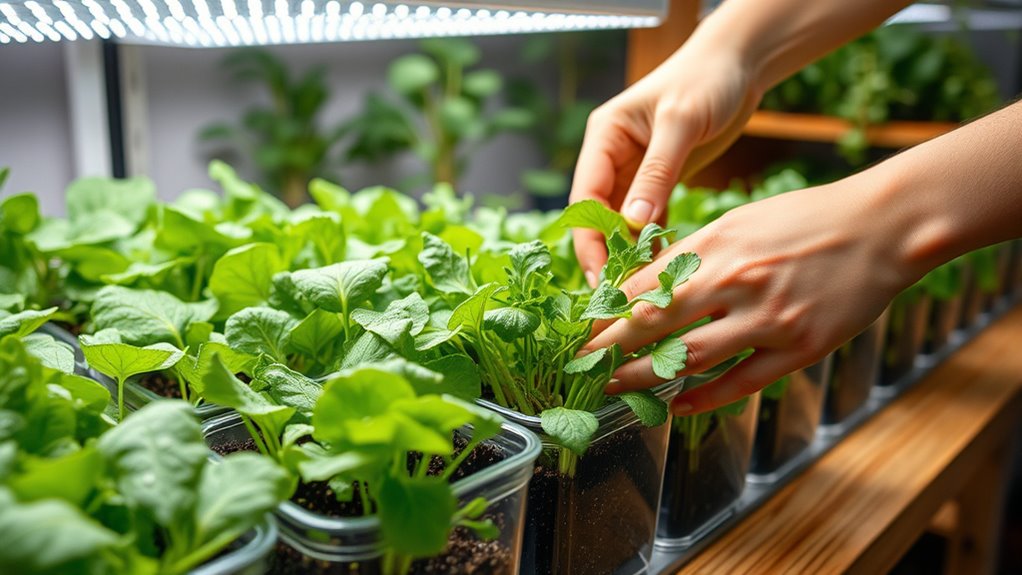
Once your salad greens have grown to a suitable size, start harvesting by snipping outer leaves about a quarter inch above the soil line. This encourages steady growth and keeps your indoor gardening vibrant.
Start harvesting outer leaves just above soil to encourage continuous, vibrant growth.
To maintain continuous greens:
- Replant cuttings or seedlings immediately after harvesting to keep your salad greens coming.
- Rotate planting cycles every 2-3 weeks for a steady supply of fresh greens all winter.
- Use remaining stems and roots to regrow new greens in water or soil, extending productivity.
Consistently keep the soil moist and provide ample light to promote rapid regrowth. Regular harvesting and replanting ensure your indoor garden produces fresh, crisp salad greens nonstop, making winter gardening both simple and rewarding.
Troubleshooting Common Challenges in Indoor Greens Cultivation
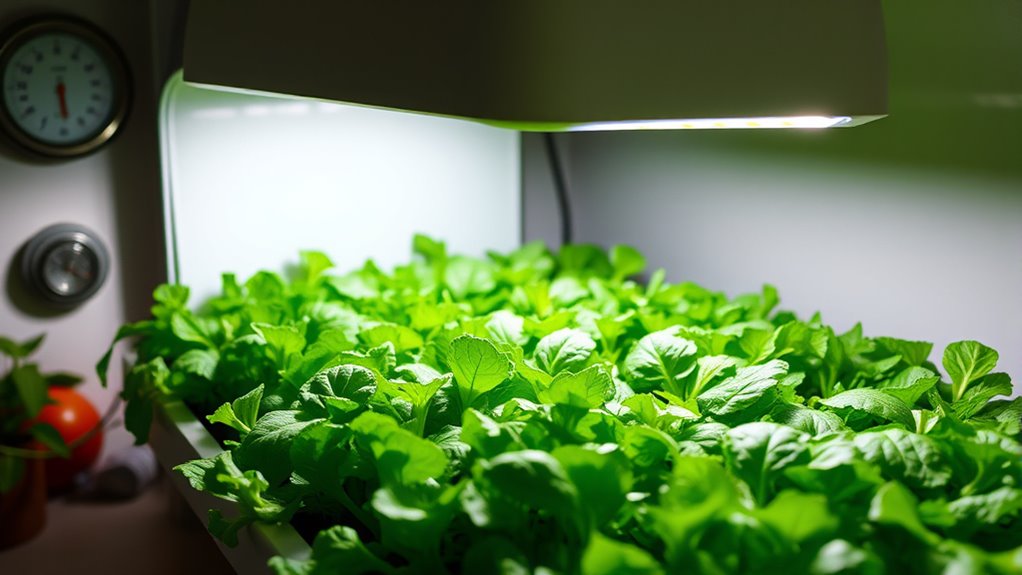
Indoor greens can face various challenges, but many of these issues stem from environmental factors or improper care. Insufficient lighting causes leggy seedlings; providing 12-16 hours of consistent artificial light prevents this. Overwatering or poor drainage can lead to root rot—use containers with drainage holes and let the soil dry slightly between watering. Temperature fluctuations and drafts stress plants, slowing growth or causing bolting; keep temperatures stable above 50°F and away from vents. Regularly inspect for pests like aphids and mold, and improve air circulation to minimize problems. Use the table below to quickly identify issues:
| Issue | Solution | Key Factors |
|---|---|---|
| Leggy seedlings | Increase lighting hours | Lighting |
| Root rot | Ensure proper drainage, avoid overwatering | Drainage, watering |
| Pest problems | Inspect regularly, improve air circulation | Pests, environment |
Tips for Incorporating Greens Into Your Indoor Decor
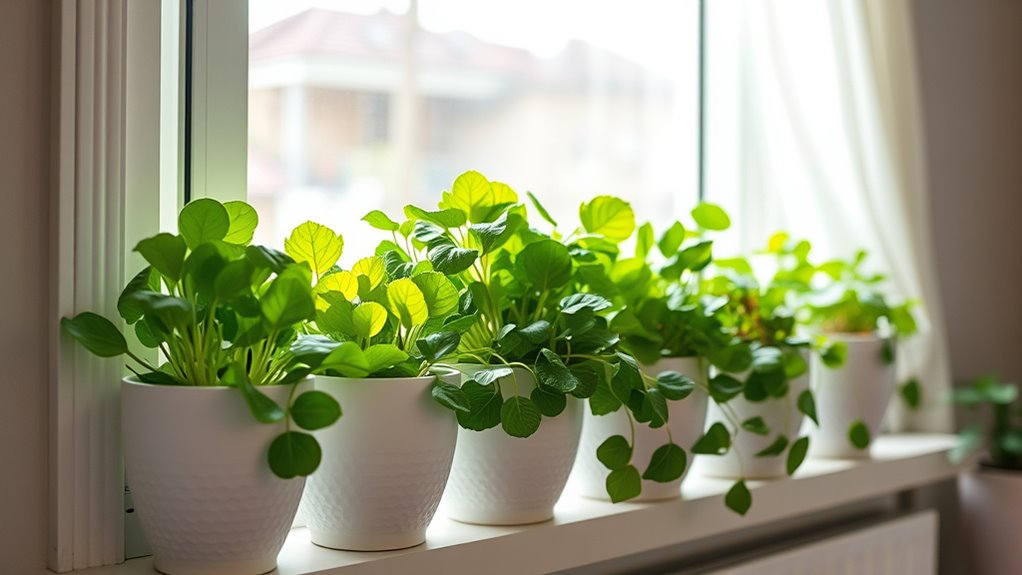
Transforming your salad greens into stylish decor is simple when you choose the right containers and display spots. Use decorative pots, like colorful ceramic or woven baskets, to showcase your greens as part of your indoor garden. Place them on open shelves or windowsills with abundant natural light, turning your greens into edible art.
Here are some tips:
- Select clear or semi-transparent containers to highlight the lush greenery and add a fresh, natural aesthetic.
- Arrange your greens alongside other houseplants to create a layered, vibrant indoor garden.
- Incorporate harvest tools and small cutting boards into your decor to emphasize the functional beauty of your edible art.
These ideas will make your salad greens both a visual delight and a practical addition to your home.
Frequently Asked Questions
Can I Grow Lettuce Indoors All Year Round?
Yes, you can grow lettuce indoors all year round. You just need to provide enough light with grow lights for 12-16 hours daily, keep the temperature around 50°F or higher, and maintain proper moisture.
Starting seeds in containers allows for continuous planting cycles, so you can harvest fresh greens whenever you want. With consistent care, you’ll enjoy tender, flavorful lettuce regardless of outdoor weather conditions.
Can Salad Greens Be Grown Indoors?
Imagine opening your kitchen window and finding fresh salad greens waiting for you—yes, you can grow salad greens indoors! With proper lighting and shallow containers, you’ll see arugula, spinach, and lettuce sprout in just a few weeks.
They thrive with consistent moisture and natural or grow lights. Growing greens indoors keeps pests away and offers you pesticide-free, crisp greens year-round, making your meals healthier and more satisfying.
How to Grow Salad Greens All Year?
To grow salad greens all year, you need to provide consistent light, water, and temperature. Use grow lights for 12-16 hours daily, keep soil moist, and maintain a warm, stable environment.
Start seeds early and replant every 2-3 weeks to guarantee a continuous harvest. Portable grow systems or soil sprouts make it easy to grow greens indoors without outdoor space, letting you enjoy fresh salads year-round.
How Do You Grow Greens All Winter?
Imagine turning your home into a lush, green oasis in the dead of winter! To grow greens all winter, set up small containers with soil in a bright spot or under grow lights.
Keep the soil moist and guarantee your plants get 12-16 hours of light daily.
Maintain a cozy temperature of at least 50°F, harvest leaves regularly, and enjoy fresh, vibrant greens no matter how cold outside.
Conclusion
Now that you’ve mastered the art of indoor salad greens, your kitchen is practically a farm-to-table paradise—minus the dirt and bugs, of course. Keep tweaking your setup, stay vigilant for pesky pests, and enjoy the endless supply of fresh greens. Who knew growing lettuce could turn into such an indoor adventure? So go ahead, get your hands dirty (or not), and savor those crisp, homegrown bites—winter’s never tasted so fresh!
